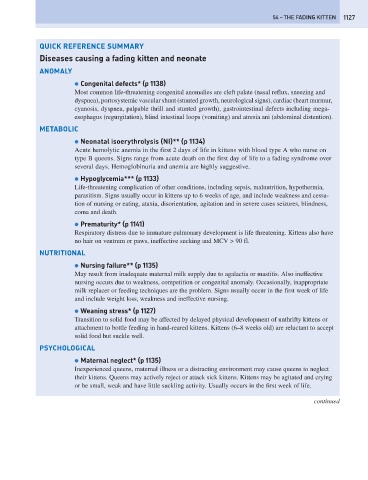Page 1135 - Problem-Based Feline Medicine
P. 1135
54 – THE FADING KITTEN 1127
QUICK REFERENCE SUMMARY
Diseases causing a fading kitten and neonate
ANOMALY
● Congenital defects* (p 1138)
Most common life-threatening congenital anomalies are cleft palate (nasal reflux, sneezing and
dyspnea), portosystemic vascular shunt (stunted growth, neurological signs), cardiac (heart murmur,
cyanosis, dyspnea, palpable thrill and stunted growth), gastrointestinal defects including mega-
esophagus (regurgitation), blind intestinal loops (vomiting) and atresia ani (abdominal distention).
METABOLIC
● Neonatal isoerythrolysis (NI)** (p 1134)
Acute hemolytic anemia in the first 2 days of life in kittens with blood type A who nurse on
type B queens. Signs range from acute death on the first day of life to a fading syndrome over
several days. Hemoglobinuria and anemia are highly suggestive.
● Hypoglycemia*** (p 1133)
Life-threatening complication of other conditions, including sepsis, malnutrition, hypothermia,
parasitism. Signs usually occur in kittens up to 6 weeks of age, and include weakness and cessa-
tion of nursing or eating, ataxia, disorientation, agitation and in severe cases seizures, blindness,
coma and death.
● Prematurity* (p 1141)
Respiratory distress due to immature pulmonary development is life threatening. Kittens also have
no hair on ventrum or paws, ineffective sucking and MCV > 90 fl.
NUTRITIONAL
● Nursing failure** (p 1135)
May result from inadequate maternal milk supply due to agalactia or mastitis. Also ineffective
nursing occurs due to weakness, competition or congenital anomaly. Occasionally, inappropriate
milk replacer or feeding techniques are the problem. Signs usually occur in the first week of life
and include weight loss, weakness and ineffective nursing.
● Weaning stress* (p 1127)
Transition to solid food may be affected by delayed physical development of unthrifty kittens or
attachment to bottle feeding in hand-reared kittens. Kittens (6–8 weeks old) are reluctant to accept
solid food but suckle well.
PSYCHOLOGICAL
● Maternal neglect* (p 1135)
Inexperienced queens, maternal illness or a distracting environment may cause queens to neglect
their kittens. Queens may actively reject or attack sick kittens. Kittens may be agitated and crying
or be small, weak and have little suckling activity. Usually occurs in the first week of life.
continued

